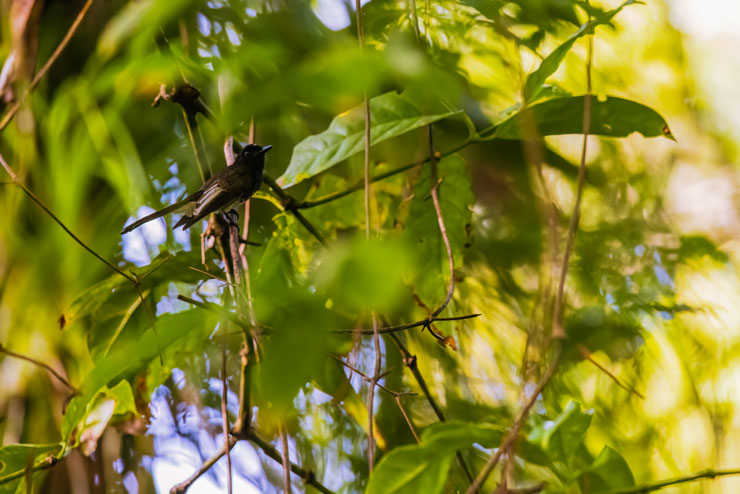It starts with a flight, then another, then another, then still, one more – to then realise that the island you’ve just landed on is only as big as the airstrip itself which by some miracle is covered in tarmac – to then get on a boat to go to a market to then get back on the boat and jettison over the waves splitting flocks of Great Crested Terns and Black Noddies as they jostle preoccupied by sub-surface goings-on. Small groups of dolphins and certainly innumerable other non-feathered creatures swarmed in the deep blue as we neared an island leaping out of the ocean, a dormant volcano with steep, verdant sides that ascended into the clouds. From above, Kolombangara Island is a near perfect circle in the Western Province of the remote Solomon Islands. From sea level, it seemed more like a mystical monster rising from the depths.
A Black Noddy cruises past one of the many uninhabited islands in the Western Province.
Some say the island looks like a sleeping woman, which influenced some concerned locals to caution me about letting my dreadlocks drift in the wind – lest the lady spirit becomes envious as her hair is not as long. Which I found a bit odd for a respectable spirit as large as an island. But anyway, I kept my head under control and on the birds.
Most audibly prominent throughout our time on the island was a selection of Long-tailed Myna, a Melanesian endemic and the architect of complex, looping notes that echoed throughout the jungle. Booming calls of Red-knobbed Imperial-Pigeon, another regional endemic, betrayed the presence of these shy yet extravagant looking pigeons. The forest would sometimes grow silent, to then be shattered by the screeches of a flock of Cardinal Lories as they careened past.

Long-tailed Myna

Red-knobbed Imperial-Pigeon

The slower and more deliberate flight of the almost all white Ducorp’s Cockatoo, however, was much easier to locate and track than the red rockets that the lories were. Once perched, however, it was considerably more complicated to locate.

Birds were easiest to find when they were in the open sky, but patient scouring of the upper reaches of the canopy would ultimately yield some avian activity. A Solomons Cuckooshrike would pass through at intervals but would not be as confiding as a pair of very inquisitive Barred Cuckooshrikes, who very considerately posed for photographs often when nothing else ever would. Occasionally, a Yellow-vented Myzomela would appear and hang upside down on swaying branches looking very much like a honeycreeper in the Neotropics. I’d have to pinch myself or wait for the prehistoric roaring of a Buff-necked Coucal to snap back to the reality of being in the South Pacific.

Solomons Cuckooshrike

I ended up with many images of Barred Cuckooshrike, they always seemed more interested in me than I was in them.

Buff-necked Coucal

Solomons White-eye

White-winged Fantail

By some divine stroke of luck, I managed to see both monarchs (not the butterfly) on the island – White-capped Monarch (upper left) and Kolombangara Monarch (middle right) on virtually the same branch. Though of different genera, both species are endemic to Kolombangara and some of the other nearby islands. Both are also listed as Near Threatened species.
For the most part, the birds remained in the treetops. Small mixed flocks of Metallic Starling and Singing Starling would occasionally rouse a resting Claret-breasted Fruit-Dove that would bolt out of its hiding place in plain sight. It is one of nature’s finest marvels that something so brilliant and vivid could sit on a branch and become invisible.

The coolest thing about the Metallic Starling is that its Latin name is metallica.

Claret-breasted Fruit-Dove
Rain on Kolombangara is a routine yet spectacular event. The name of the island translates to “Water Lord”; when the clouds gather and thunder claps one is forced to pay attention. Swirling air currents often bring raptors into view, when the rain comes it does so with a measured confidence. Once it blows over, however, the birds would emerge. On the treetops, of course.

You’ll just have to trust me on this: Pied Goshawk

The long wings and wedge-shaped tail of a Sanford’s Sea-Eagle render it near unmistakable.
Birding Kolombangara Island undoubtedly is not the easiest commute – but the island has much to offer. There is a conservation line that protects all forest above 400m, below which the logging company makes its money. Had I not been throughly flogged by flying for 24 hours prior to my arrival, I would surely have made it to a higher altitude. Oh well, there’s always next time.
Source link

